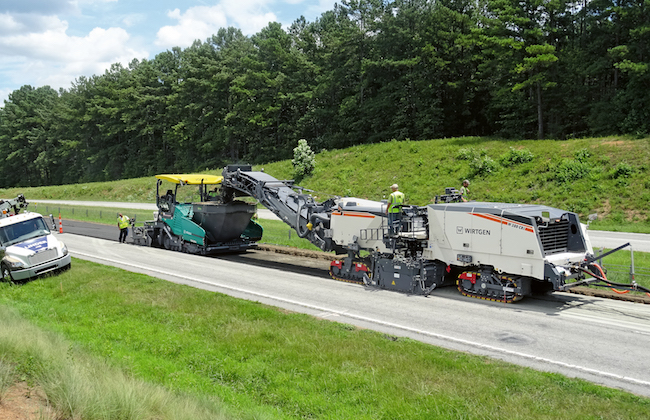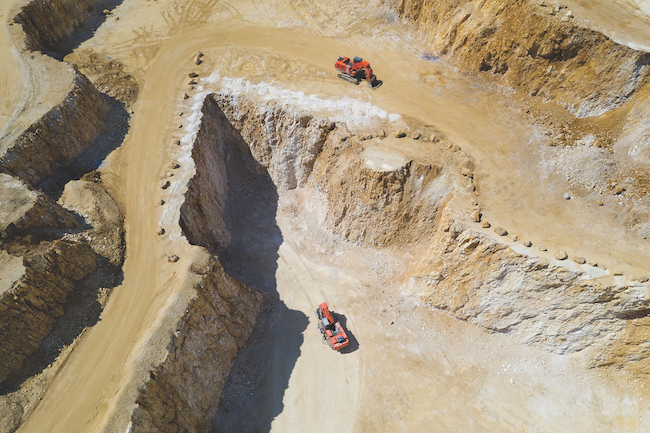
‘A perfect storm’: Changing conditions give cold recycling processes room to grow
By David Kennedy
Green Construction Roads
A range of factors, from material costs to sustainability are rejigging how asphalt road repair projects are taking shape. PHOTO: Adobe Stock/Vadim
On traditional road repair projects, ministries and municipalities don’t often look too far beyond remove and replace. Contractors dig out or mill the material, haul it to a stockpile or landfill and then truck in aggregate from quarries or hot mix plants to repave the road.
It’s the way it’s historically been done and there’s nothing wrong with the process, says Mark Stahl, the director of Recycling Products at Wirtgen America. But faced with limited resources, high transportation costs for materials, the need for shorter construction timeframes and increased momentum for more sustainable ways of working, he anticipates renewed interest in a different approach to asphalt road repairs.
“It’s almost like a perfect storm in the fact that you have this significant green push across the board,” Stahl says. “And two, a lot of our agencies — whether it be the DOTs, or the ministries up in Canada — are feeling budget strains and our pavement structure in general is not improving. It’s getting significantly worse because of the amount of traffic that we’re putting on these pavements that were designed 30 or 40 years ago.”
“All this leads to finding a better way to maintain and rehabilitate our pavement systems,” he adds.

A Wirtgen cold recycler in action. The W 380 CRi can take on cold in-place or full-depth recycling projects. PHOTO: Wirtgen
As an alternative, cold in-place recycling (CIR) checks all the boxes, Stahl says, noting he’s seeing increased traction for recycling processes that use 100 per cent of the material already present on-site. Adding to equation, those materials have already been paid for by taxpayers.
The method itself is nothing new. Trevor Moore, corporate technical director for the Miller Group, says the road construction and paving firm introduced CIR to Canada in 1989.
As the name implies, crews carry out the CIR process entirely in-place, typically milling the existing road to create a mat of between 75 to 110 millimetres. The material is crushed to the appropriate size, mixed with new binders and laid back down in the same cavity created by the milling process.
“That produces a brand new recycled pavement that is free of all of the distresses that existed prior to milling,” Moore says. “After it’s placed, it’s rolled, typically with steel and pneumatic rollers to achieve the density that’s required for the material and for the specifications.”
Those agency-developed specifications, include the requirement of a mix design that creates a recipe to be followed during construction that varies from project to project.
To finalize the work, a seal of some kind, such as hot-mix asphalt, chip seal, or microsurfacing, is almost always required.
Among other positives, Moore points to time, cost, hauling and environmental savings as the key benefits.
“Since you’re not excavating materials, you’re not taking any material off-site, you’re not bringing a lot of new material onto site, there is an inherent improvement in time,” he says. “You’re not damaging adjacent roadways while trucking material away and bringing material back, so there’s a good socio-economic impact because the roads won’t deteriorate as quick and there’s not as much truck traffic on the road.”
Though Moore saw adoption of CIR on Ontario roads trend upward through the 1990s until the early 2010s, he says use of the process then plateaued and has declined somewhat over the past five years. Still, he anticipates higher material costs and the recent focus on employing more environmentally-friendly processes will drive wider adoption of the method in the years ahead.
“It’ll come back, it is the clear pavement rehabilitation choice,” he says.
Cost savings are another benefit. A report from the Ontario Ministry of Transportation, issued under the previous Liberal government, cites cost savings of 40 to 50 per cent compared to conventional treatments, along with 50 per cent fewer greenhouse gas emissions and the consumption of 62 per cent less aggregate. Much of the savings comes from reusing material taxpayers have already paid for in the new pavement structure.

Recycling technology can limit the amount of new aggregate contractors have to haul in from quarries. PHOTO: Getty Images/Bim
CIR is also not the only cold recycling technology the industry has its eyes on. Both Moore and Stahl point to cold central plant recycling (CCPR) as another promising alternative for roadways.
Turning to CCPR would let ministries make use of stockpiles of recycled asphalt pavement (RAP), which have typically been growing in recent years, Stahl says.
“When a contractor puts RAP through in hot mix, it’s usually capped out at 15 or 25 per cent,” he says. “The cold central plant process allows 100 per cent utilization of RAP.”
Similar to CIR, but not done as part of a single sequence, CCPR uses recycled pavement reinvigorated with binding agents. The material is processed at a central plant and then hauled to site where it is laid down with normal asphalt pavers and compacted.
Though Moore notes the process is “in its infancy” in Ontario, he said with the limits placed on the amount of RAP in hot mix in Ontario in 2017, CCPR’s ability to make use of entirely recycled material creates a significant opportunity.
“I think it’s a grossly under-utilized available technology that really mimics the performance of cold in-place recycling that we’ve experienced excellent results with since 1989,” he says. Overall, Moore says owners need to look at both incorporating more in-place recycling to avoid trucking RAP away from roadways and at the cold central plant process to make use of RAP that is hauled away.
Some gaps remain.
Doubra Ambaiowei, technical director with Ontario Road Builders’ Association (ORBA), sees growth opportunities for the cold processes in Ontario and across Canada, but points to a lack of performance information as one of the areas holding it back.
“Data has not usually been kept to support how to evolve the technology,” he says.
Likewise, Moore says inconsistencies between lab testing and actual performance has been a drawback for both CIR and CCPR. For instance, in certain cases, pavement has held up well in real-world conditions, but lab results have shown quality issues. He notes both governments and contractors are working on ironing out the problems, and he anticipates more research will fill in the testing gap as recycling becomes more and more of a priority.
Along with growing interest in Ontario, Moore says demand for the cold recycling technologies will likely increase in the Manitoba market in the years ahead as well. And while Canada’s western provinces have been slow to adopt the processes, he expects to see steady demand in Quebec and the Maritimes.
This article first appeared in the February 2021 edition of On-Site. To read through the whole issue, click here.




